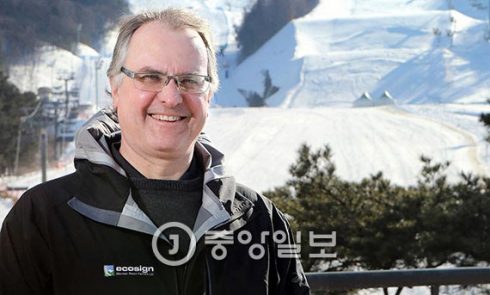
Dave Felius, a world-renowned authority on ski-course design, is laughing in front of his slopes-style course at Phoenix Snow Park. [Pyeongchang]
Freestyle skiing and snowboarding are held at Phoenix Snow Park.
Ski items include: Aerials ▶ Moguls ▶ Ski Cross ▶ Halfpipe ▶ Slopestyle
Snowboard items include: ▶ Parallel Tournament ▶ Half-Pipe ▶ Snowboard Cross ▶ Big Air ▶ Slopestyle. Aerial acrobatics and so on.
I met him at Phoenix Snow Park on the 14th and heard the philosophy of course design. Felius said confidently, “The Phoenix Snow Park course will be a wonderful venue that will excite many people.”
Ecosign has designed over 400 ski resorts in 41 countries around the world.
The ski course design was his dream from childhood. Since 1988, he has worked in Canadian Ecosign, a global ski resort and resort design firm. In Korea, he designed Welly Healy Park in Gangwon Province and the Konjiam Resort Course in Gyeonggi Province.
I have already designed the Olympic course four times. He started designing the Salt Lake City course in 2002, Vancouver in 2010, Sochi in 2014 and the Pyeongchang Olympic course in 2014. Felius said, “Phoenix Snow Park is the first ever Olympic event ever made by recycling existing courses.” Asked to design a Phoenix snow park in 2013, he sought six candidates with the goal of making the most of the existing course and minimizing development.
Mogul, half pipe, and aerials followed the standards set forth by the International Ski Federation (FIS). On the other hand, the skier-cross, the slope style, and the parallel tournament added artistic elements while following the standards.
“I thought in the head what kind of pictures would be drawn in the stadium when the athletes played their tricks, and on top of that, I put some artistic elements on them,” said Felius. “In the case of cross stadiums with many obstacles such as waves and sloping walls, I also consulted with professional designers.”
After the Olympics, I was also worried about post-employment plans. A representative example is the half pipe stadium where the four-day World Cup tournament is held from the 16th. The scale of the course was reduced at the basic civil engineering stage.
After the Olympics, ordinary skiers can enjoy the course easily. “If you spray as much snow as possible during the Olympics, you can fit the stadium specification,” Felius said. The Ski Cross Stadium was carefully designed to be used as a mountain bike course from spring to autumn.
“The 1988 Calgary Olympic skiing course was built for the Olympics but later turned into a popular course for the general public. I looked forward to winter as well as summer, “he said.
Felius named the two courses, “Pyeong” and “Pang”, which are divided into two separate classes. The athletes who played in the course and the officials concerned also praised it as “the best course ever.” “The audience will see the ski ‘big show’ at Phoenix Snow Park,” Felius said. “Completing the stadium is ultimately the skill of the players. After the Olympics, more Koreans look forward to finding this ski resort.”

